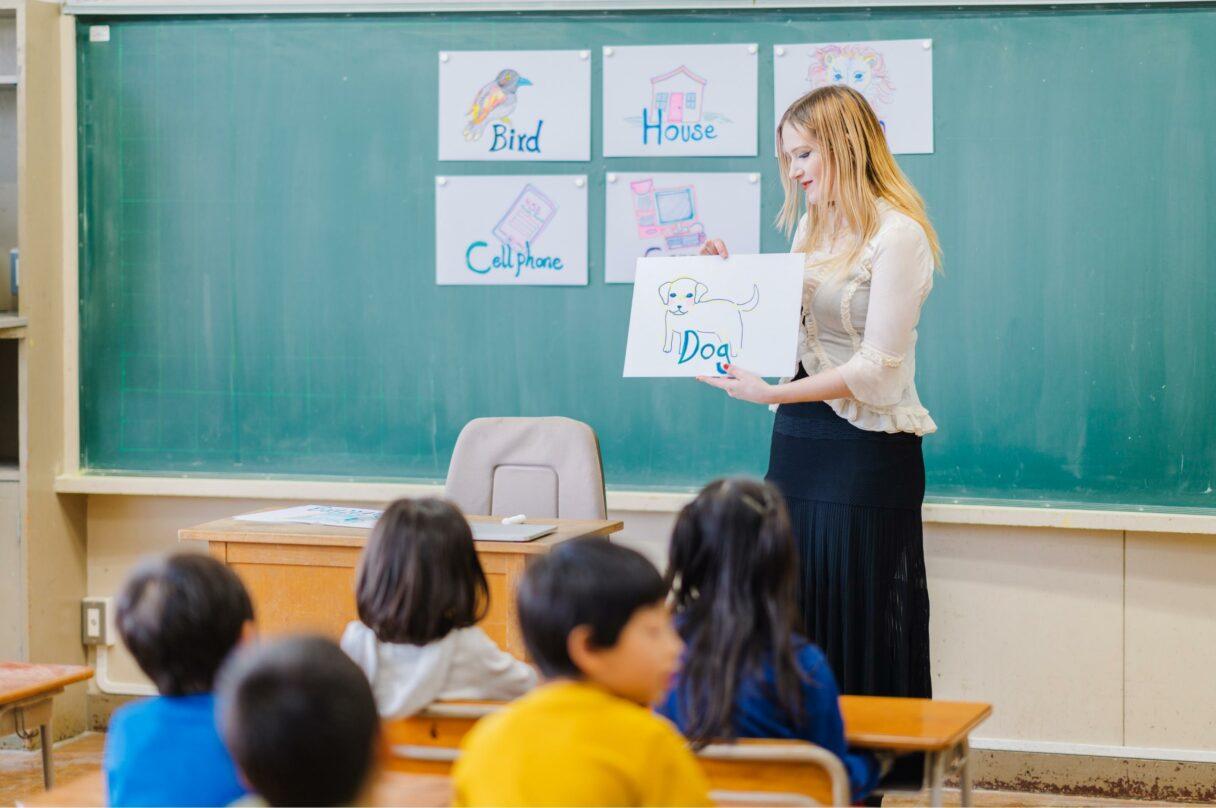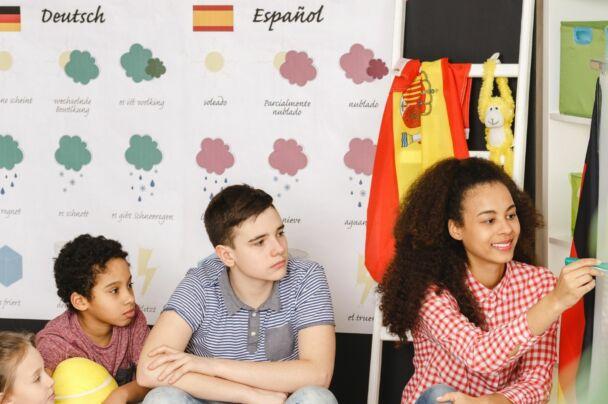Introduction to CLIL
As a CLIL teacher myself, I often use the example of a content course that would interest me and that is taking a course about French cinema (content) in French (language), while on a study abroad holiday in Paris (of course!). Since French is not my mother tongue, this kind of course would expose me to learning about the specific content of interest to me while also learning about (and becoming more fluent) in the French language.
So, what does CLIL mean?
CLIL stands for Content and Language Integrated Learning and it has officially been around since the 1990s. It is an educational approach that originally stems from Communicative Language Teaching (CLT) and has been used mostly by language teachers.
The concept is often credited to David Marsh. CLIL incorporates both the learning of content and the learning of a foreign language which is often English, but it could be teaching in any foreign language that is not the mother tongue of the students.
When we think of content, CLIL is often about the teaching of academic subject matter such as science, history, or geography, but it can also be about the teaching of any other kind of content which is less academic and, some may say, more fun subject matter such as photography, fashion, cooking, or cinema.
CLIL refers to situations where subjects, or parts of subjects, are taught through a foreign language with dual-focused aims, namely the learning of content and the simultaneous learning of a foreign language.
David Marsh, University of Jyväskylä, Finland (1994)
Soft CLIL and hard CLIL: what is the difference?

Soft CLIL is often applied in young learner (primary school) classrooms and is mostly about teaching words and vocabulary in a foreign language i.e., getting students familiar with a second language by providing some limited exposure, while still teaching primarily in the mother tongue. Soft CLIL is appropriate for lower proficiency levels such as beginning and elementary.
Hard CLIL means that an entire course is taught in a foreign language and learners need to be at an intermediate or above proficiency level and already be quite autonomous in the second language. In a course where everything is in a foreign language, learners need to be confident in the second language and have some substantial experience studying it already.
The challenges of planning CLIL Lessons
I once attended a conference where the presenter mentioned that CLIL was a good way for primary and secondary schools to get 2 for 1. In other words, an academic subject teacher and a language teacher are represented by one individual i.e., two for the price of one.
As with anything, difficulties can arise when a trained language teacher becomes an academic subject teacher, and when the trained academic subject teacher becomes the language teacher.
What is really needed, but not easily obtained, is for every CLIL course to have access to two teachers; an academic subject teacher expert and a language teacher expert who knows how to teach a foreign language to non-native speakers.
CLIL and language teachers – challenges and the good news
If you are a language teacher, one of the biggest challenges you will face in the teaching of an academic subject is a lack of background knowledge in the teaching of specific academic content.
Furthermore, developing this expertise may not be a realistic expectation because many language teachers have been trained to teach a foreign language and may not have a higher specialized degree in an academic content area.
The Good news: If you are a language teacher, you have expertise in how to teach a foreign language to non-native speakers and you are already sensitive to working with these kinds of learners.
You know how to execute activities for second language learners and are used to checking on learners’ comprehension and dealing with error correction in both writing and speaking activities.
CLIL and academic subject teachers – challenges and the good news
If you are an academic subject teacher, you may have an advanced degree in history or geography but no experience in teaching language and you may find that you are unable to make the necessary modifications to make your content knowledge comprehensible to language learners.
You may also find difficulties with teaching their subject matter in a foreign language if you, too, are non-native speakers of the language required to teach.
The Good news: If you are an academic subject teacher, you have content area expertise, which a language teacher might lack. You probably have a very specialized degree and you are an expert in your areas of study which could be anything from history, geography, art, science, or math. Since you might also be native speakers, you will know how to communicate their subject matter effectively if the mother tongue is used.
How to implement CLIL in your classroom
CLIL is driven by academic or other subject-matter content and teachers who are interested in (or required to) incorporate this approach in their classroom need to know and understand how to create and incorporate the teaching of the four skills reading, writing, listening, and speaking to non-native speakers of a language effectively and in a beneficial way for their learners.
The Receptive Skills: Listening and Reading CLIL activities

Anything that students receive in a foreign language is referred to as input. The receptive skills are known as Listening and Reading and require that all teachers check on their learners’ comprehension of what has or has not been understood.
A formula for Listening activity (with handout):
- Pre-teach difficult or unknown vocabulary words
- Listen first time for gist – without handout
- Listen second time for specific details – with questions on handout
- This step can be skipped if over 50% of questions have been answered: Listen a third time for confirmation and to get missed details.
After the second or third listening, individual students can share and compare with those around them before coming back together as a class to confirm anything else that they are unsure about or that they were unable to discern with their partner or partners.
In the CLIL in Secondary School – Practical Activities for All Teachers course in Florence, Italy, the second day focuses on teaching CLIL through Science. In one of the first listening activities, the 2006 movie trailer An Inconvenient Truth is used in a cloze activity*.
The first listening allows students to listen to and watch the 3-minute trailer. Before the second listening, students are given a handout where 12 words from the transcript are provided in a word bank at the top of the worksheet. During the second listening, students are required to fill in the missing words in the text without the visual of the video to allow them to focus solely on listening.
As mentioned in the above formula, students can skip the third listening if they were able to fill in at least 50% of the missing words.
*Cloze Activity – an activity in which words are removed from a passage for a learner to fill in as an exercise in reading comprehension. The missing words may or may not be provided in a word bank.
A formula for Reading Activity (with handout):
- Pre-teach difficult or unknown vocabulary words and highlight them in the text
- Students Read first time aloud (dividing up reading equally by sentences or paragraphs) to practice pronunciation
- Students read second time silently for comprehension
At this point, students can complete comprehension questions with or without the text, individually, or with a partner or partners. If comprehension questions are answered without the text, they can be answered with a partner through speaking and relying on memory of what was read together.
In another example from the course CLIL in Secondary School – Practical Activities for All Teachers, the third day focuses on teaching CLIL through History. In one of the reading activities, a short reading passage about the life of Henry VIII, a former King of England, is passed out. For the first reading, each student is allowed to read at least one sentence aloud.
During the second reading, students read silently (on their own) and are asked to write their names at the top of the handout when they have finished. Teachers can collect the reading passage from all students when they have finished reading.
As mentioned in the above formula, individual students or pairs are given one handout with 12 comprehension questions to answer without the ability to refer to the reading passage for answers.
The Productive Skills: 5 ways to do Writing and Speaking activities

Anything that students produce in a foreign language is referred to as output. The productive skills are known as Writing and Speaking and require that teachers engage in error correction which can be done by the teacher, the student, or a peer depending on what needs to be corrected, student level, and or the activity.
Students can work on productive activities (where writing and speaking are required) in any of the following ways:
- Individually (1)
- Pairs (2)
- Small groups (3-4)
- Two teams 50/50
- Whole class
On the fourth day of the course CLIL in Secondary School – Practical Activities for All Teachers, the focus is on teaching Geography through CLIL. Students are required to produce a roleplay, using speaking, based on the travels of Marco Polo. On this day, a two-minute film clip from the 2014 film Marco Polo is used.
First students choose the role they would like to play. Then they are provided with the transcript from the film. After highlighting their role(s) and what they need to say, they Listen and watch – paying attention to the character they are playing and how they sound. The next step (depending on how many students there are in class) is to put students in small groups, two teams, or as a whole class to practice the script.
When each group is ready, students perform. There can be more than one performance and everyone else who participates as the audience can provide oral or written feedback. If students are studying the part of the world where Marco Polo explored, they can also research and write about different cities along his route.
Using authentic CLIL resources
Since CLIL is all about knowing how to prepare and implement reading, writing, listening, and speaking activities to non-native speakers of a language, teachers who are particularly creative and dedicated to their craft, can seek out Authentic Materials from the real world to develop their courses.
If I use the same example of learning more about French cinema in the French language while enjoying a holiday in France, I could, for example, think about incorporating movie trailers (listening); short interviews (in French) found on YouTube with film directors or French actors (listening); include movie reviews of films in French (reading); anything about the places, people, or events that take place in any film (reading).
I could also engage my learners in speaking and writing activities that get students to express their opinions or thoughts about certain films, French actors and actresses, film topics, locations depicted in French films, timelines, genres, or songs used in French movies. Students could be asked to create movie posters or a short guide to French films perhaps from different time periods as a fun project.
Conclusion and resources

Many countries and educational institutions around the world are promoting the teaching and learning of both content and language through CLIL. For example, the European Union (EU) also embraces it.
The language policy of the EU, drawn up by the European Parliament at the Social Summit held in Gothenburg, Sweden in 2017, declares that by 2025, young citizens of the EU should be learning and able to speak at least two additional European languages along with their native tongue by the time they complete school.
As we all know, competence in more than one foreign language plays an important role in improving educational and employment opportunities. The argument then is that through CLIL students can simultaneously study academic or other subject matter through a foreign language at school which will help them reach a good level of multilingualism by the time they become an adult.
Teachers should therefore have an integrated and well-prepared education themselves to help them properly prepare their own students to be open-minded European citizens who speak more than one language.
Since CLIL is about teaching content through a foreign language. It can serve as an approach to provide meaningful language use driven by specific content, CLIL is not only an important instrument for fostering European citizens’ language learning goals; it is a way to embrace language diversity and a deeper understanding of other EU countries and ways of life.
If you would like to know more about CLIL, I have an exiting news to share!
After 10 years of teaching CLIL to more than 1’000 European teachers, I recently had the opportunity to create an online course on it. The best part?
Thanks to the Erasmus+ project EUTEAM, the course is 100% free!
The MOOC clarifies the CLIL methodology and introduces several examples of CLIL activities focusing on EU content and the original EU members–with authentic (real world) materials in English.
It offers several activity handouts ready to be used in the classroom, along with questions for reflection for the students.
Click on the following link to register:
Furthemore, within our catalogue of Erasmus courses for teachers, we have an entire selection of more than 20 courses focused on CLIL!
They are all week-long courses that focuses on how to create reading, writing, listening, and speaking activities in academic subject matter such as science, history, geography, and art.
English is the language for which this specific content is taught. All these courses are filled with a multitude of activities to help both the language and academic subject teacher gain a better understanding of managing an effective CLIL classroom experience for both learners and teachers.

